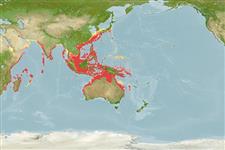Common names from other countries
Environment: milieu / climate zone / depth range / distribution range
Ecologia
marinhas demersal; intervalo de profundidade 10 - 155 m (Ref. 9824). Tropical; 37°N - 32°S, 35°E - 160°E
Indo-West Pacific: definitely recorded from Inhambane, Mozambique; throughout the Indian Ocean to Java, Sumatra, Viet Nam, Philippines, Taiwan, South Korea, Japan, and Lord Howe Island (Ref. 9824).
Tamanho / Peso / Idade
Maturity: Lm ? range ? - ? cm
Max length : 27.0 cm TL macho/indeterminado; (Ref. 9824)
Espinhos dorsais (total) : 0; Raios dorsais (total) : 87 - 97; Espinhos anais: 0; Raios anais : 61 - 73. Distinguished by cycloid scales on the ocular side, except for upper and lower margins of body, and a shorter lower jaw (2.3 to 2.9 times in head length). Body almost circular in shape in young, becoming ovate with growth.
Rare species (Ref. 9824). Found in sandy and muddy areas of the continental shelf (Ref. 5213). Feeds on benthic animals (Ref. 9824). Most sexually dimorphic characters develop at about 8 cm SL (Ref. 9824). Marketed fresh or used in making fish meal (Ref. 9824).
Ciclo de vida ou comportamento de acasalamento
Maturities | Reprodução | Spawnings | Egg(s) | Fecundities | Larvas
Hensley, D.A., 1986. Bothidae. p. 854-863. In M.M. Smith and P.C. Heemstra (eds.) Smiths' sea fishes. Springer-Verlag, Berlin. (Ref. 4417)
Status na Lista Vermelha da UICN (Ref. 130435)
CITES (Ref. 128078)
Not Evaluated
Ameaça para os humanos
Harmless
Uso pelos humanos
Pescarias: espécies comerciais
Ferramentas
Relatórios especiais
Baixar XML
Fontes da internet
Estimates based on models
Preferred temperature (Ref.
115969): 22.1 - 28.4, mean 27.1 (based on 860 cells).
Índice de diversidade filogenética (Ref.
82804): PD
50 = 0.5000 [Uniqueness, from 0.5 = low to 2.0 = high].
Bayesian length-weight: a=0.01000 (0.00426 - 0.02347), b=3.07 (2.89 - 3.25), in cm Total Length, based on LWR estimates for this Genus-body shape (Ref.
93245).
Nível Trófico (Ref.
69278): 3.5 ±0.37 se; based on food items.
Resiliência (Ref.
120179): médio(a), tempo mínimo de duplicação da população 1,4 - 4,4 anos (Preliminary K or Fecundity.).
Fishing Vulnerability (Ref.
59153): Low vulnerability (17 of 100).
